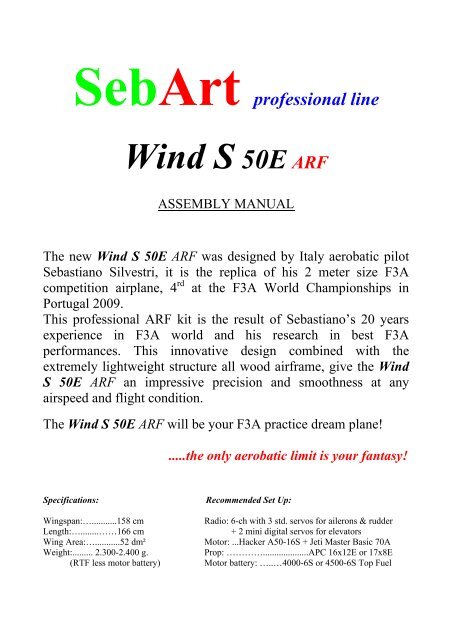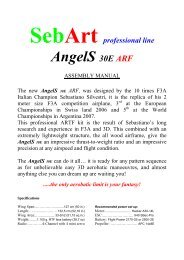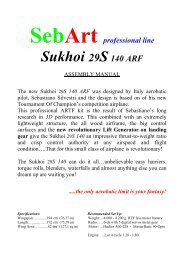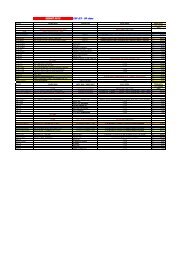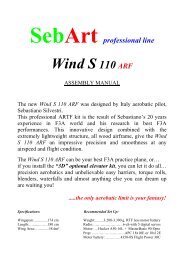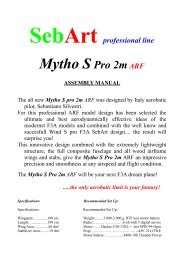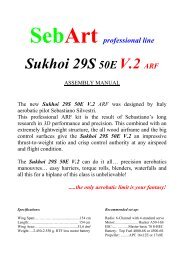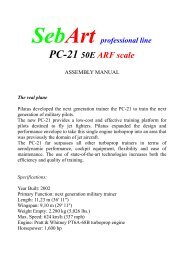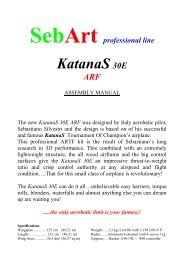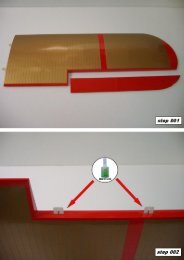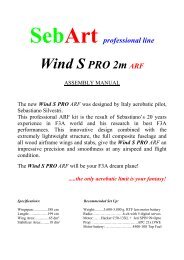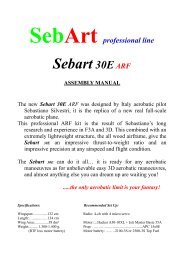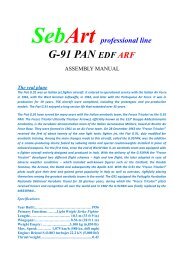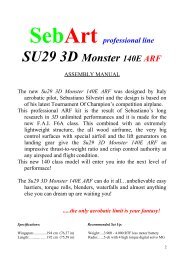Create successful ePaper yourself
Turn your PDF publications into a flip-book with our unique Google optimized e-Paper software.
SebArt professional line<br />
Wind S 50E ARF<br />
ASSEMBLY <strong>MANUAL</strong><br />
The new Wind S 50E ARF was designed by Italy aerobatic pilot<br />
Sebastiano Silvestri, it is the replica of his 2 meter size F3A<br />
competition airplane, 4 rd at the F3A World Championships in<br />
Portugal 2009.<br />
This professional ARF kit is the result of Sebastiano’s 20 years<br />
experience in F3A world and his research in best F3A<br />
performances. This innovative design combined with the<br />
extremely lightweight structure all wood airframe, give the Wind<br />
S 50E ARF an impressive precision and smoothness at any<br />
airspeed and flight condition.<br />
The Wind S 50E ARF will be your F3A practice dream plane!<br />
.....the only aerobatic limit is your fantasy!<br />
Specifications:<br />
Wingspan:…...........158 cm<br />
Length:…........……166 cm<br />
Wing Area:…...........52 dm²<br />
Weight:......... 2.300-2.400 g.<br />
(RTF less motor battery)<br />
Recommended Set Up:<br />
Radio: 6-ch with 3 std. servos for ailerons & rudder<br />
+ 2 mini digital servos for elevators<br />
Motor: ...Hacker A50-16S + Jeti Master Basic 70A<br />
Prop: …………....................APC 16x12E or 17x8E<br />
Motor battery: …..…4000-6S or 4500-6S Top Fuel
Required radio, motor and battery<br />
Radio equipment:<br />
• Minimum 6-channel radio system<br />
• 5 digital servo: 3 JR DS 9511 or DS 9401 (ailerons and rudder) + 2 JR DS 3201 (elevators)<br />
• 2 servo extensions 900mm, for elevator’s servos<br />
• 1 extension 500mm, for rudder servo<br />
Recommended electric motor for best performance:<br />
• Hacker A50-16S + Jeti Master Basic 70A SBec + APC 16 x 12E or 17x8E<br />
• Battery pack Top Fuel 4000-6S or 4500-6S<br />
Additional required item, tools and adhesives<br />
Tools:<br />
• Drill<br />
• Drill bits: 1,5mm; 2mm; 2,5mm; 3mm<br />
• Phillips screwdriver<br />
• Hobby knife<br />
• Masking tape<br />
• Paper towels<br />
• Rubbing alcohol<br />
• Sand paper<br />
• Soldering iron<br />
• synthetic oil<br />
Adhesives:<br />
• 5-minute epoxy<br />
• thin CA<br />
• medium CA<br />
Warning<br />
This RC aircraft is not a toy!<br />
If misused, it can cause serious bodily harm and damage to property.<br />
Fly only in open areas, preferably in official flying sites, following all instructions included with<br />
your radio and motor.<br />
This plane is a compromise between Aerobatics and 3D flying, and not a pylon racer.<br />
It is built with a very light structure and for this reason we hardly recommend:<br />
→ Do NOT fly your airplane at high speeds, because this may cause structural<br />
failures or flutter due to the extremely large control surfaces.
Before starting assembly<br />
Before starting the assembly of your Wind S 50E, remove each part from its bag and protection for<br />
a prior inspection. Closely inspect the fuselage, wing panels, rudder, and stabilizer for damage. If<br />
you find any damage or missing parts, contact the place of purchase.<br />
If you find any wrinkles in the covering, use a heat gun or covering iron to remove them. Use<br />
caution while working around areas where the covering material overlap to prevent separating the<br />
covers.<br />
Warranty information<br />
SebArt garantees this kit to be free from defects in both material and workmanship at the date of<br />
purchase.<br />
This warranty does not cover any parts damage by use or modification, and in no case shall<br />
SebArt’s liability exceed the original cost of the purchased kit.<br />
Further, SebArt reserve the right to change or modify this warranty without notice.<br />
In that SebArt has no control over the final assembly or material used for the final assembly, no<br />
liability shall be assumed or accepted for any damage of the final user-assembled product. By the<br />
act of using the product, the user accepts all resulting liability.<br />
If the buyer is not prepared to accept the liability associated with the use of this product, the buyer<br />
is advised to return this kit immediately in new and unused condition to the place of purchase.<br />
Control throws<br />
Please, follow the recommended linkage setups:<br />
For the AILERONS we recommend the following throws:<br />
High rate: 40° left & right<br />
Normal flight: D/R: 30% Expo: 20%<br />
Snap: D/R: 100% Expo: 90%<br />
Spin & 3D: D/R: 100% Expo: 90%<br />
For the ELEVATOR we recommend the following throws:<br />
High rate: 40° up & down<br />
Normal flight: D/R: 30% Expo: 30%<br />
Snap: D/R: 40% Expo: 50%<br />
Spin & 3D: D/R: 100% Expo: 95%<br />
For the RUDDER we recommend the following throws:<br />
High rate: 40° left & right<br />
Normal flight: D/R: 40% Expo: 60%<br />
Snap: D/R: 50% Expo: 70%<br />
Spin & 3D: D/R: 100% Expo: 90%<br />
Note: the Expo is (+) for JR systems, and (–) for Futaba systems.
Mixing<br />
For best performance, we recommend a linear-mix*:<br />
Rudder → Elevator UP<br />
When you give full rudder to the right or left side, the elevator have to go up (positive) approx. 2%<br />
Rudder → Ailerons<br />
When you give full rudder to right the ailerons need to go left approx. 1%<br />
When you give full rudder to left the ailerons need to go right approx. 1%<br />
* if you have a programmable computer radio.<br />
NOTE: Elevator trim<br />
For a vertical straight downline the elevators need to be trimmed down (negative) approx. 2mm,<br />
this is NORMAL !<br />
Recommended CG<br />
The recommended Center of Gravity location is 205mm behind the leading edge of the wing<br />
against the fuselage.<br />
‣ 200mm is good for windy condition.<br />
‣ 210mm is good for no wind condition.<br />
You can use the battery pack, moving it forward or backward, to achieve the correct balance.<br />
Range test your radio<br />
Before fly, be sure to range check your radio as manufacturer’s instruction manual of you<br />
radio-system recommend.<br />
Double-check all controls (aileron, elevator, rudder and throttle) move in the correct<br />
direction.<br />
Be sure that your batteries are fully charged, as per the instructions included with your<br />
batteries and that your radio is fully charged as per its instructions.<br />
...good flights!<br />
SebArt di Sebastiano Silvestri<br />
Via Trento 69/3<br />
38017 Mezzolombardo (TN) – Italy<br />
www.sebart.it


